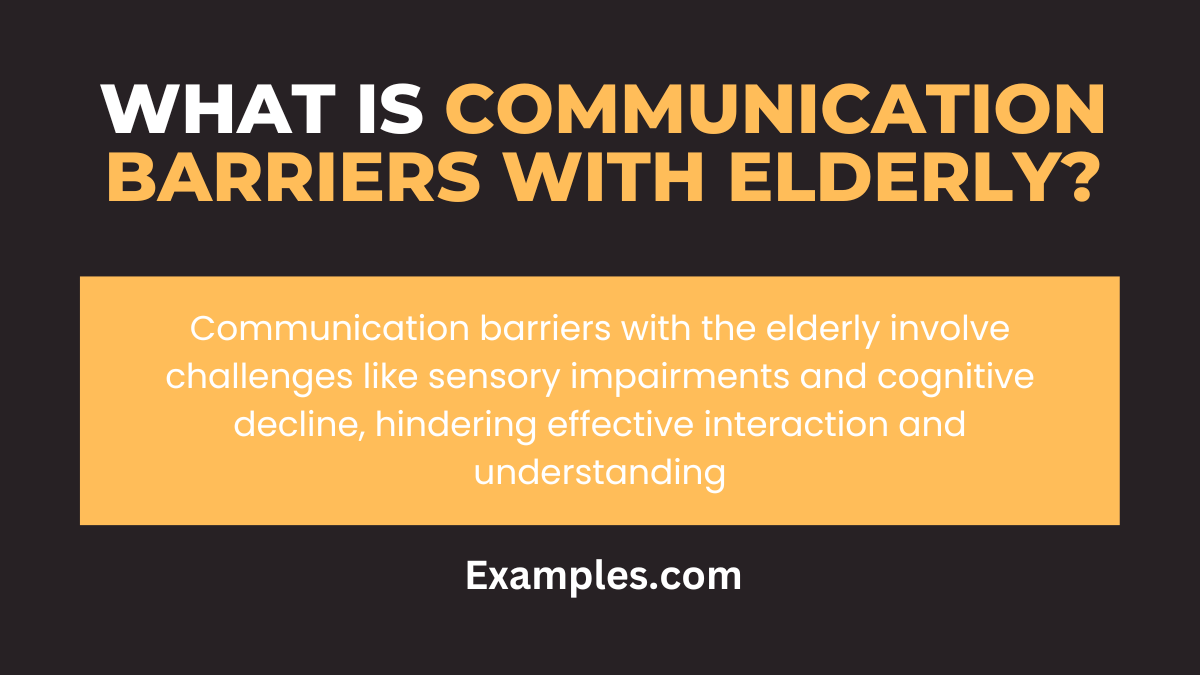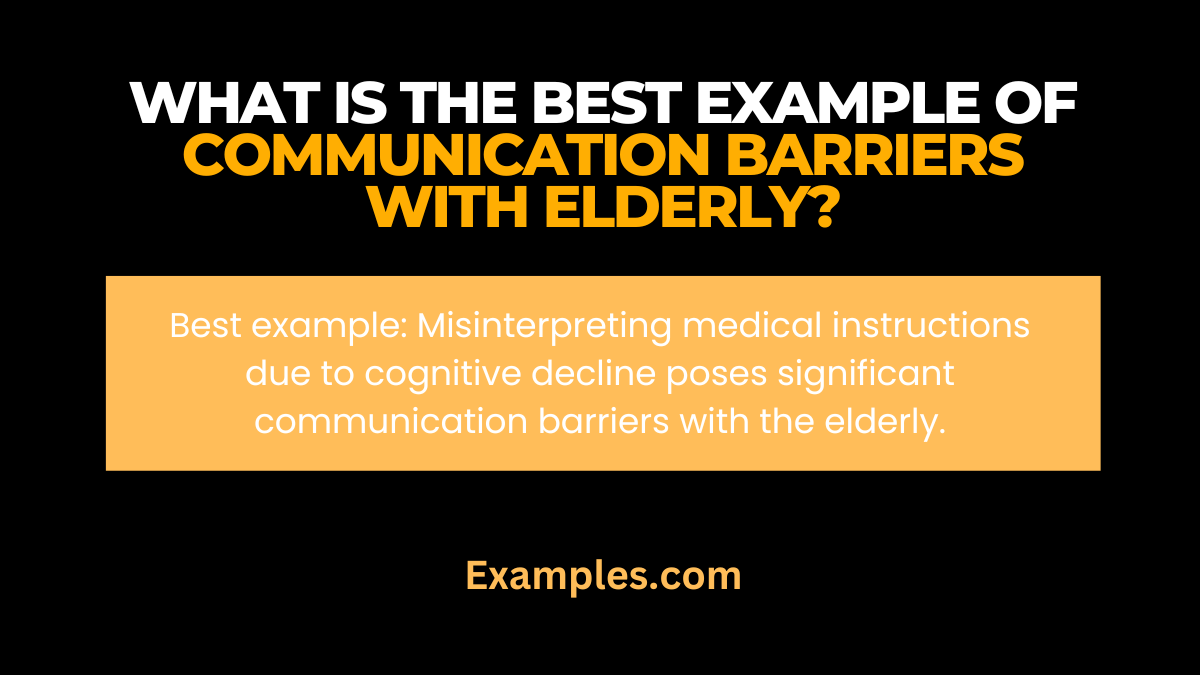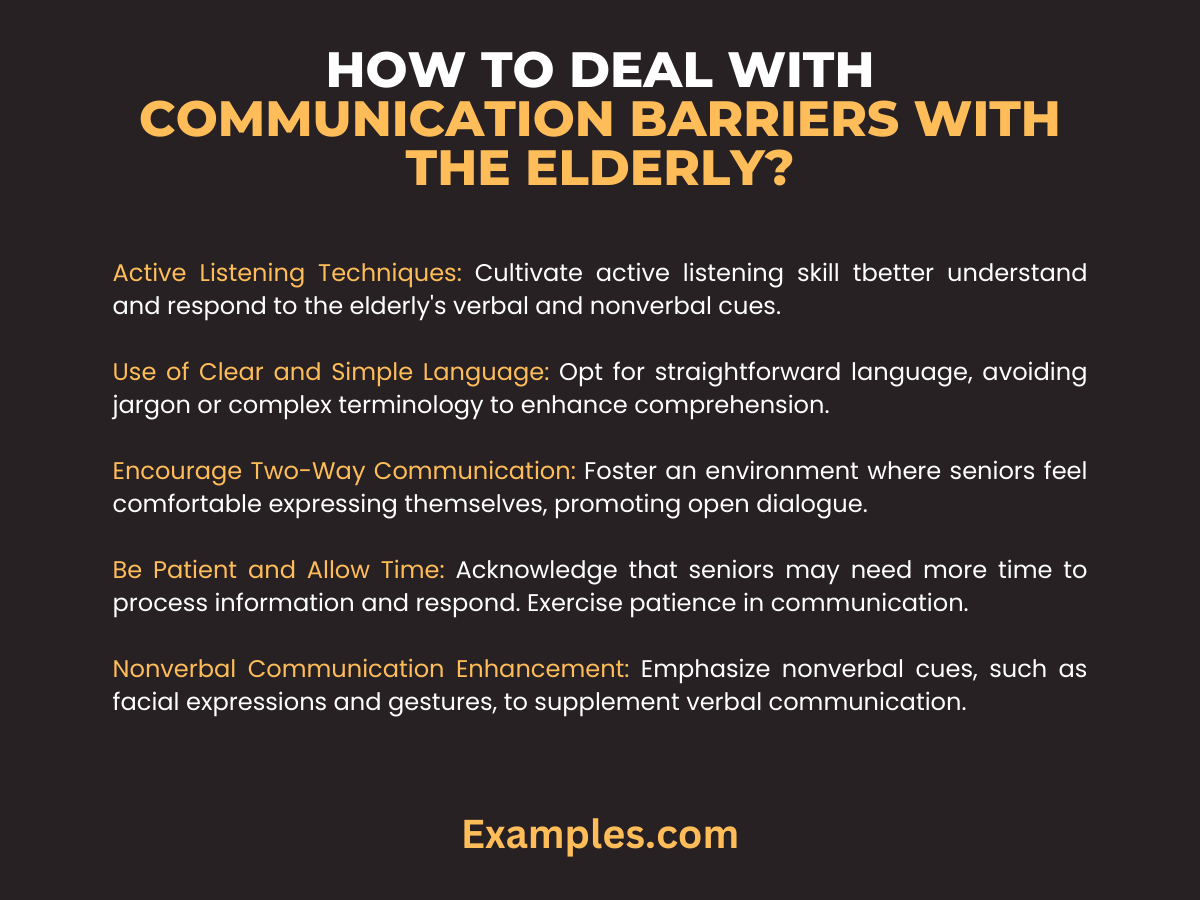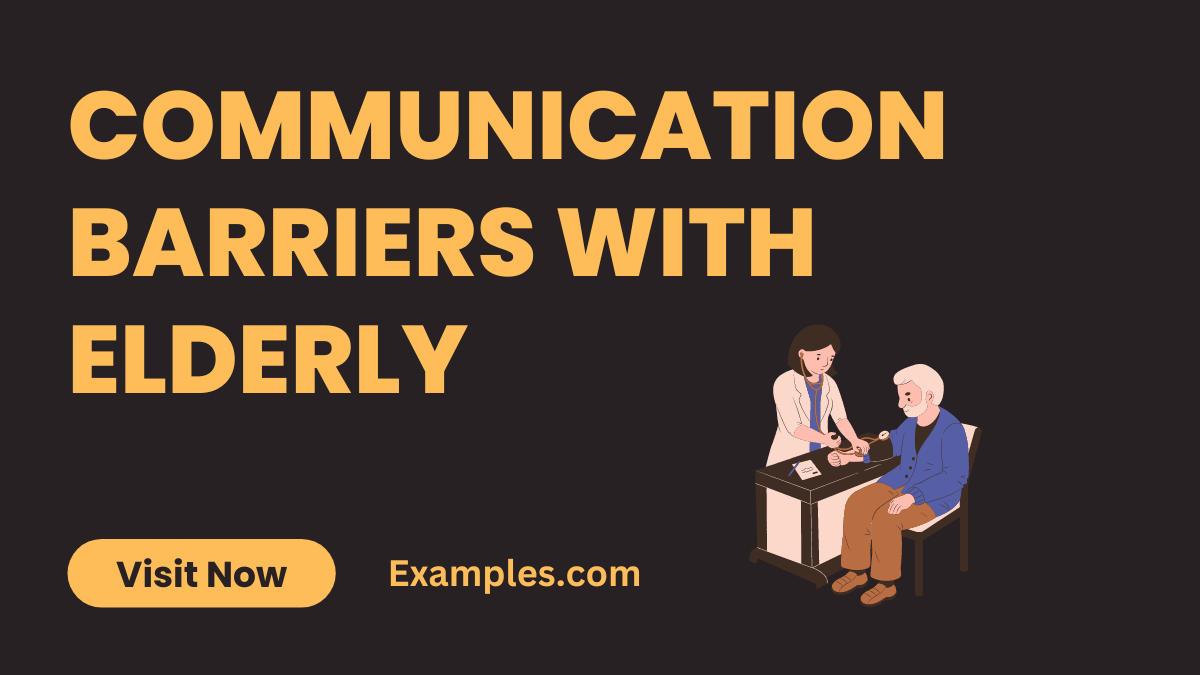9+ Communication Barriers with Elderly Examples
Navigating effective communication with the elderly is crucial, and understanding the nuances of Communication Barriers is key. In this comprehensive guide, we delve into the intricacies, providing practical “Communication Examples” to illuminate the challenges and solutions. Explore actionable tips to enhance your interpersonal skills, decode nonverbal cues, and foster meaningful connections. Elevate your communication prowess in elder interactions, breaking down barriers for more meaningful and enriching connections.
What is Communication Barriers with Elderly?

Communication Barriers with the elderly refer to obstacles hindering effective interaction between individuals of advanced age and their counterparts. These barriers can manifest in various forms, from sensory impairments to generational gaps. This H2 guide elucidates a simplified definition, shedding light on the challenges faced in communicating with the elderly, fostering a deeper understanding of the nuanced dynamics at play. Uncover insights into overcoming these barriers for more harmonious and meaningful connections.
What is the best Example of Communication Barriers with Elderly?

One poignant example illustrating communication barriers with the elderly involves the use of modern technology. As society embraces digital communication, seniors may encounter challenges in adapting to new devices and platforms. This H2 guide delves into the intricacies of this scenario, exploring how unfamiliarity with technology can impede meaningful interactions. Learn how to bridge this gap, foster digital literacy, and enhance communication with the elderly, ensuring inclusivity and understanding in an ever-evolving technological landscape.
10 Communication Barriers with Elderly Examples
Explore 20 examples of Communication Barriers with the Elderly, each shedding light on distinct challenges. This concise guide enhances your understanding of effective communication with seniors.
- Visual Impairment:
- Difficulty with small fonts.
- Use larger print, audio descriptions.
- Generational Language Gap:
- Struggle with modern slang.
- Find common ground, explain terms.
- Hearing Loss:
- Speaking too rapidly.
- Face the person, adjust volume.
- Digital Communication Challenges:
- Complex platforms without guidance.
- Provide tutorials, offer support.
- Medical Jargon Misunderstanding:
- Using complex terms.
- Simplify, use analogies.
- Cultural Sensitivity Lapses:
- Ignoring cultural nuances.
- Practice sensitivity, tailor communication.
- Assumption of Helplessness:
- Treating as incapable.
- Respect autonomy, involve in decisions.
- Memory Loss Challenges:
- Expecting detailed recall.
- Use reminders, repeat key information.
- Environmental Distractions:
- Noisy environments.
- Choose quiet spaces, minimize noise.
- Nonverbal Misinterpretations:
- Misreading body language.
- Clarify intentions, be mindful of cues.
Communication Barriers with Elderly Patients:
Navigate the intricate landscape of communication barriers with elderly patients in this insightful guide.
insights to enhance your interactions, fostering better healthcare communication
- Cognitive Impairment:
- Difficulty understanding complex medical information.
- Simplify language, use visual aids.
- Fear of Confrontation:
- Hesitation to ask questions or express concerns.
- Create a welcoming environment, encourage open dialogue.
- Health Literacy Challenges:
- Limited understanding of medical terms and procedures.
- Use plain language, provide written materials.
- Trust Issues:
- Skepticism towards medical advice or treatment.
- Establish rapport, address concerns transparently.
- Limited Mobility:
- Difficulty in physically reaching out to healthcare providers.
- Offer accessible communication channels, consider home visits.
- Sensory Impairments:
- Challenges in hearing or seeing medical instructions.
- Use clear, amplified communication and visual aids.
- Anxiety about Procedures:
- Apprehension towards medical tests or interventions.
- Provide detailed explanations, address fears with empathy.
- Cultural and Language Barriers:
- Misunderstandings due to language or cultural differences.
- Use interpreters, be culturally sensitive in communication.
- Reluctance to Share Information:
- Withholding crucial health details due to privacy concerns.
- Build trust gradually, assure confidentiality.
- Medication Management Challenges:
- Difficulty following complex medication schedules.
- Simplify instructions, use pill organizers, and offer reminders.
Importance of Communication Barriers with Elderly:
Understanding the significance of communication barriers with the elderly is crucial for fostering meaningful connections. Delve into this gaining insights into the pivotal role these barriers play in shaping interactions with seniors.
- Physical Health Impact:
- Navigating mobility challenges during communication.
- Opt for comfortable seating and maintain eye level for ease.
- Mental Health Implications:
- Overlooking the impact on cognitive well-being.
- Use clear language, be patient, and provide visual aids.
- Emotional Connection Breakdown:
- Neglecting emotional cues and expressions.
- Acknowledge emotions, offer support, and validate feelings.
- Social Isolation Consequences:
- Unintentionally isolating seniors from social interactions.
- Foster inclusivity, encourage group activities, and facilitate social connections.
- Quality of Life Affected:
- Underestimating the impact on overall well-being.
- Prioritize active listening, address concerns promptly, and involve them in decision-making.
- Medical Care Misunderstandings:
- Misinterpreting medical instructions and needs.
- Simplify medical information, involve family members, and ensure clarity in healthcare discussions.
- Identity and Dignity Preservation:
- Disregarding the need to preserve individual identity.
- Acknowledge personal preferences, respect choices, and involve them in relevant decisions.
- Financial Decision Challenges:
- Assuming seniors’ financial understanding without clarification.
- Provide clear financial information, offer assistance, and involve them in financial discussions.
- Safety Concerns Overlooked:
- Ignoring safety precautions in communication.
- Prioritize safety discussions, provide clear instructions, and address potential hazards.
- Cultural Sensitivity Impact:
- Neglecting cultural considerations in communication.
- Embrace cultural diversity, tailor communication, and respect individual backgrounds.
What are Communication Problems Associated with the Elderly?
Navigating effective communication with the elderly requires an understanding of the unique challenges they face. We explore the intricate landscape of communication problems associated with the elderly, shedding light on crucial aspects that impact interactions and relationships.
- Sensory Impairments:
- Seniors often grapple with visual and hearing impairments, affecting the reception of verbal and nonverbal cues.
- Cognitive Decline:
- Age-related cognitive decline can lead to memory issues, making it challenging to process and retain information.
- Generational Language Gap:
- Variances in language use and understanding may create communication barriers between different age groups.
- Technological Disconnect:
- Limited exposure to modern technology may hinder seniors’ ability to engage in digital communication effectively.
- Health-Related Communication Challenges:
- Seniors dealing with health issues may find it challenging to articulate their needs and comprehend medical information.
- Social Isolation Impact:
- Limited social interactions can contribute to feelings of loneliness, impacting the overall quality of communication.
- Medication-Related Communication:
- Complex medication regimens may pose challenges in understanding and following prescribed instructions.
- Loss of Independence:
- Communication problems may arise when seniors feel a loss of independence, affecting their willingness to express needs and preferences.
- Environmental Factors:
- Noisy or crowded environments can make it difficult for the elderly to concentrate and engage in effective communication.
- Emotional Barriers:
- Past experiences, grief, or emotional challenges may create barriers, impacting the ability to connect emotionally.
How to Deal with Communication Barriers with the Elderly?

Effectively addressing communication barriers with the elderly involves understanding their unique challenges and employing empathetic strategies. We explore practical approaches to enhance communication, fostering meaningful connections with seniors.
- Active Listening Techniques:
- Cultivate active listening skills to better understand and respond to the elderly’s verbal and nonverbal cues.
- Use of Clear and Simple Language:
- Opt for straightforward language, avoiding jargon or complex terminology to enhance comprehension.
- Encourage Two-Way Communication:
- Foster an environment where seniors feel comfortable expressing themselves, promoting open dialogue.
- Be Patient and Allow Time:
- Acknowledge that seniors may need more time to process information and respond. Exercise patience in communication.
- Nonverbal Communication Enhancement:
- Emphasize nonverbal cues, such as facial expressions and gestures, to supplement verbal communication.
In conclusion, this comprehensive guide unravels the intricacies of communication barriers with the elderly. By exploring real-world examples and providing practical insights, it equips readers with the knowledge to navigate challenges effectively. Understanding and addressing these barriers fosters meaningful connections, promoting empathy, and enhancing the overall communication experience with the elderly.



